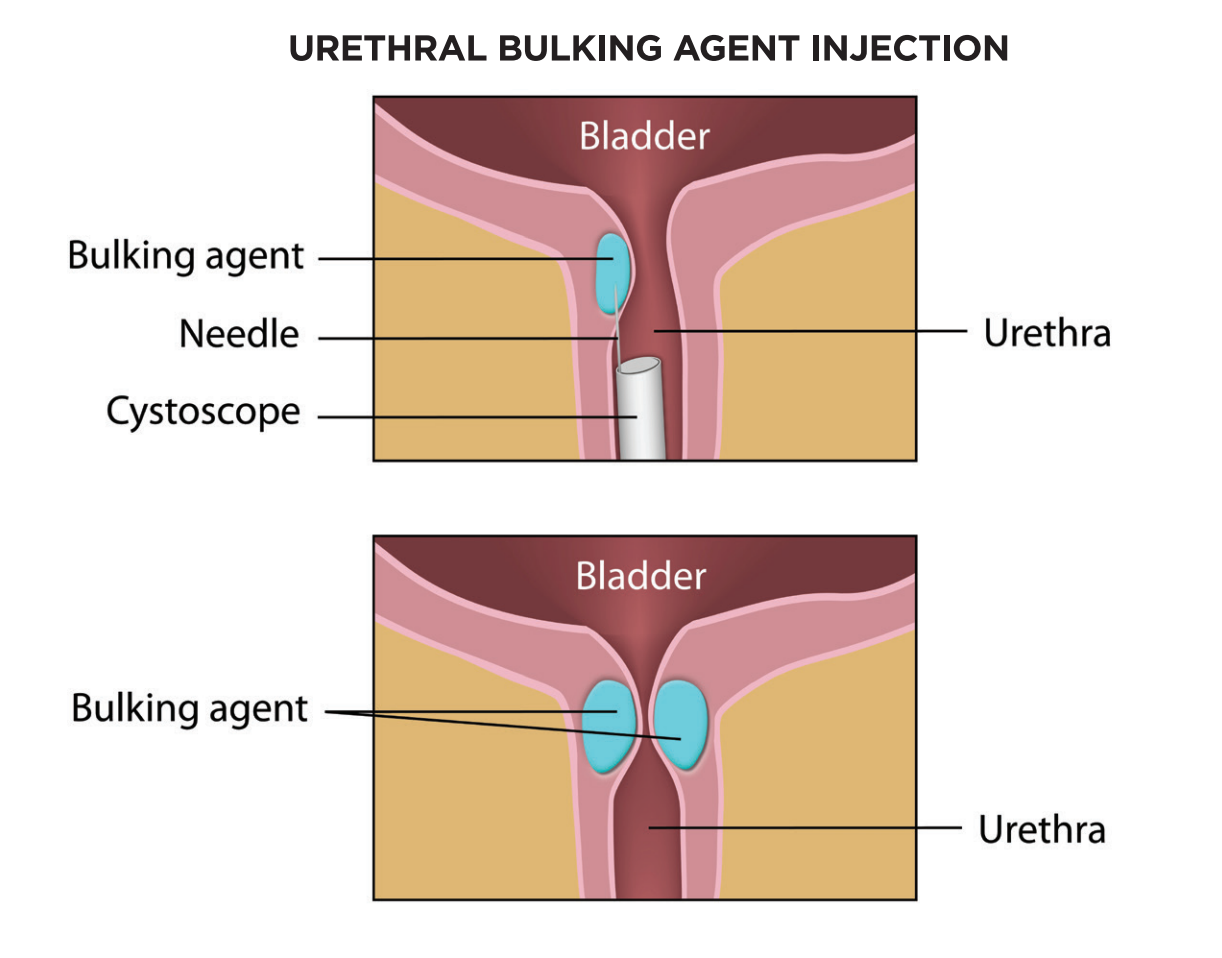Urethral bulking is a procedure that involves injecting a material, called a bulking agent, around the walls of the urethra to narrow its width. This can treat stress urinary incontinence (SUI).
About Urethral Bulking
Urethral bulking injections are a treatment for SUI. Injections may also be used for women that still leak after surgery. With a thin telescopic camera (called a cystoscope) inserted into the urethra, the doctor uses a thin needle to inject the bulking agent around the walls of the urethra. This helps to hold in urine when you are doing activities like coughing, sneezing, or exercising.
There are different materials used as bulking agents. All of them are made of soft, hypoallergenic beads floating in a dissolvable gel. Ask your doctor which bulking agent will be used for your procedure.
Unfortunately, this procedure is not a permanent cure, and the effects often wear off over time. For women who have successful results, most will require another injection in about 6 to 24 months. These can be done indefinitely. Even though the injection is near the vagina, it won’t cause vaginal pressure or pain, even with intercourse.
Urethral bulking is a good option for women who are not currently interested in surgery, including those who are planning a future pregnancy or who have serious medical conditions.
As with other medical procedures, urethral bulking has risks. Discuss these with your doctor before the procedure. Some of the risks include:
- Pain during the injection.
- Blood in the urine right after the procedure. Small amounts are normal and are a temporary side effect.
- Pain with urination.
- Urinary tract infection (UTI). Fewer than one in ten women who have a urethral bulking injection will need treatment for a UTI.
- Difficulty emptying the bladder (called “urinary retention”). Women who experience this need to catheterize themselves temporarily. This happens about 10 percent of the time.
- Shifting of the bulking material near the site of injection.
LEARN THE TERMS
- Catheter: Plastic tube temporarily placed to drain urine from your bladder.
- Cystoscope: A thin tube with a small telescopic camera on the end that is used to visualize the inside of the bladder.
- Stress urinary incontinence (SUI): Urine leakage with physical activity such as laughing, sneezing, lifting, or exercise.
- Urethra: The tube-like structure from the bladder to the outside of the body that urine passes through during urination.
- Urethral bulking: Injecting a material–called a bulking agent–around the walls of the urethra to narrow its width and help reduce leakage of urine with coughing or sneezing.
HOW THE PROCEDURE IS DONE
Urethral bulking is usually performed in a doctor’s office. You do not need general anesthesia or an overnight hospital stay. You can eat and drink normally on the day of the procedure. The actual procedure takes about 20 minutes. However, the entire visit may require one to two hours.
When you arrive, you’ll need to give a urine sample. This sample will be checked for signs of UTI. If you have a UTI, the procedure will need to be rescheduled. If you have symptoms of a UTI at home, call the office right away.
Once you are numb, the doctor will begin the procedure. With the cystoscope in the urethra, the doctor injects the bulking agent (often into 2 to 4 sites) using a needle. This can be painful briefly.
Before you go home, you’ll be asked to urinate. Sometimes the injections cause difficulty emptying the bladder. These symptoms occur in less than 10 percent of women. If you cannot urinate, the doctor’s assistant will teach you how to catheterize yourself. Typically, this is only needed for a couple of days.
AFTER THE PROCEDURE
There is no need to restrict your activity after this procedure.
Contact your doctor’s office if you experience any of the following symptoms:
- Trouble urinating or a sense that the bladder isn’t emptying.
- Heavy bleeding, including bright red-colored urine or large clots in the urine.
- Burning with urination, changes to the color or smell of urine, or chills and fever (greater than 101 degrees Fahrenheit).
- The need to urinate more frequently.
Ask when you should schedule a follow-up appointment. At this time, the doctor will reassess your symptoms and possibly consider another injection.
THREE TAKEAWAYS
1. Urethral bulking is a procedure to treat SUI. It involves the injection of a bulking agent around the walls of the urethra to narrow its width and help hold In urine.
2. Urethral bulking injections are usually performed at a doctor’s office. You do not need general anesthesia or a hospital stay. You can usually drive yourself and can return to work immediately after the procedure.
3. Urethral bulking has a 60 to 70 percent success rate for women with SUI. The effects tend to reduce over time. Many women require repeated Injections.






